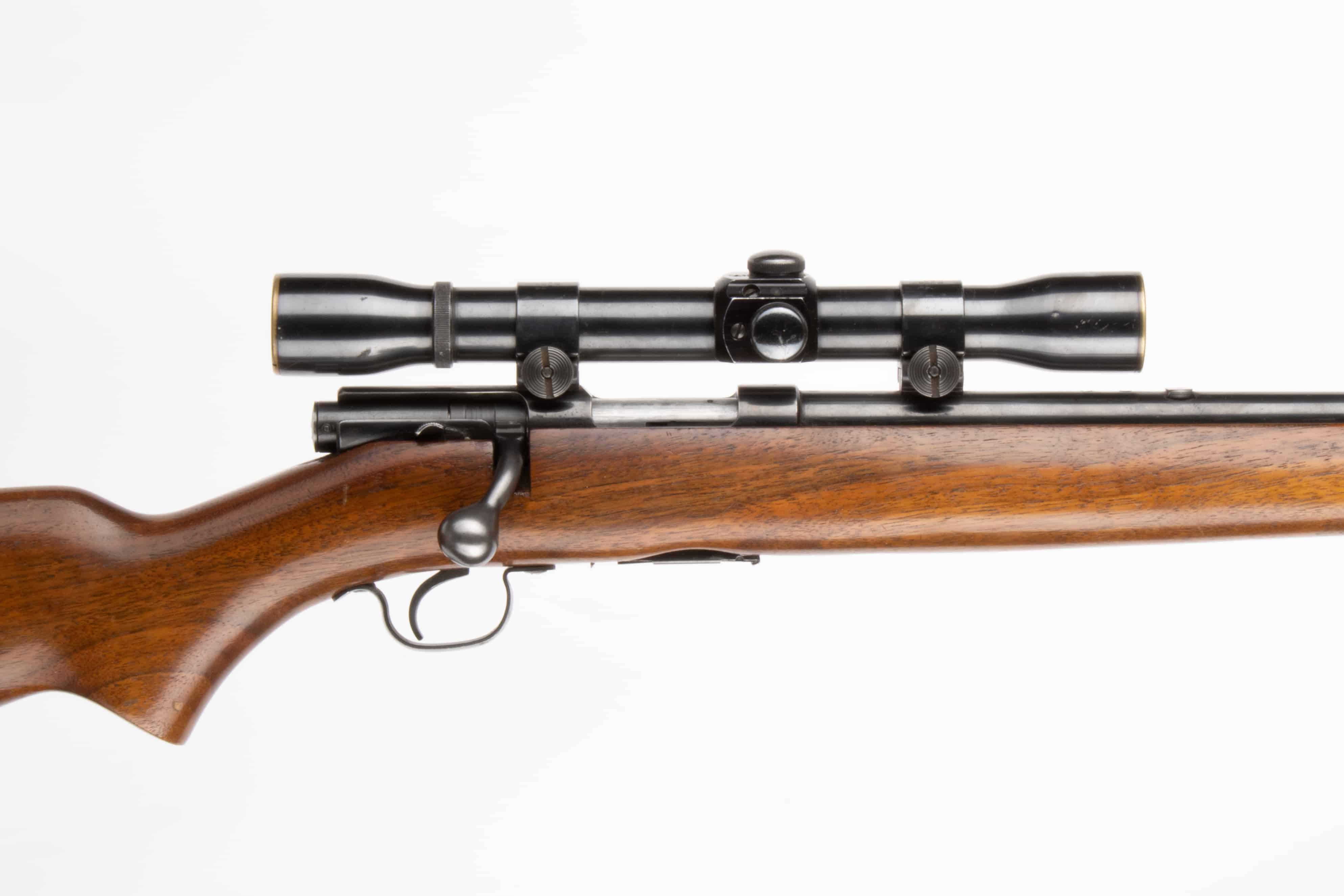
The Winchester Model 43 is a relatively little-known rifle compared to the company’s many legends, such as the Model 94 and Model 70. Manufactured from 1948 to 1953, the Model 43 was chambered for the 25-20 Win, 32-20 Win, 218 Bee, and 22 Hornet cartridges. This small framed bolt-action rifle is a perfect varmint rifle that is both accurate and reliable.
The Winchester Model 43 is far from being a poor man’s Model 70. In fact, they aren’t even in the same class and are so different that it makes you wonder why it got that reputation. It was manufactured and sold at the same time as the Model 70, but that is where the similarities stop.
My first rifle was a Winchester Model 43 chambered in the 218 Bee. My grandpa gave me that rifle before I was old enough to talk. I love that rifle and have taken red foxes, coyotes, woodchucks, rabbits, ground squirrels, and everything in between. When I did more research on the rifle, I realized there was little information on these rifles. Even The Winchester Book by George Madis negates even mentioning the existence of the Model 43. I intend to change this lack of information with this series of articles.
Affiliate Disclosure: This article may contain affiliate links. When you use these links, I earn a small commission from each sale generated at no cost to you. This commission helps me continue to put out free content. I work a full-time job that I am very happy with; therefore, I don’t need this commission and am not obligated to speak highly of any product. Everything written is my own opinion: the good, the bad, and the ugly.
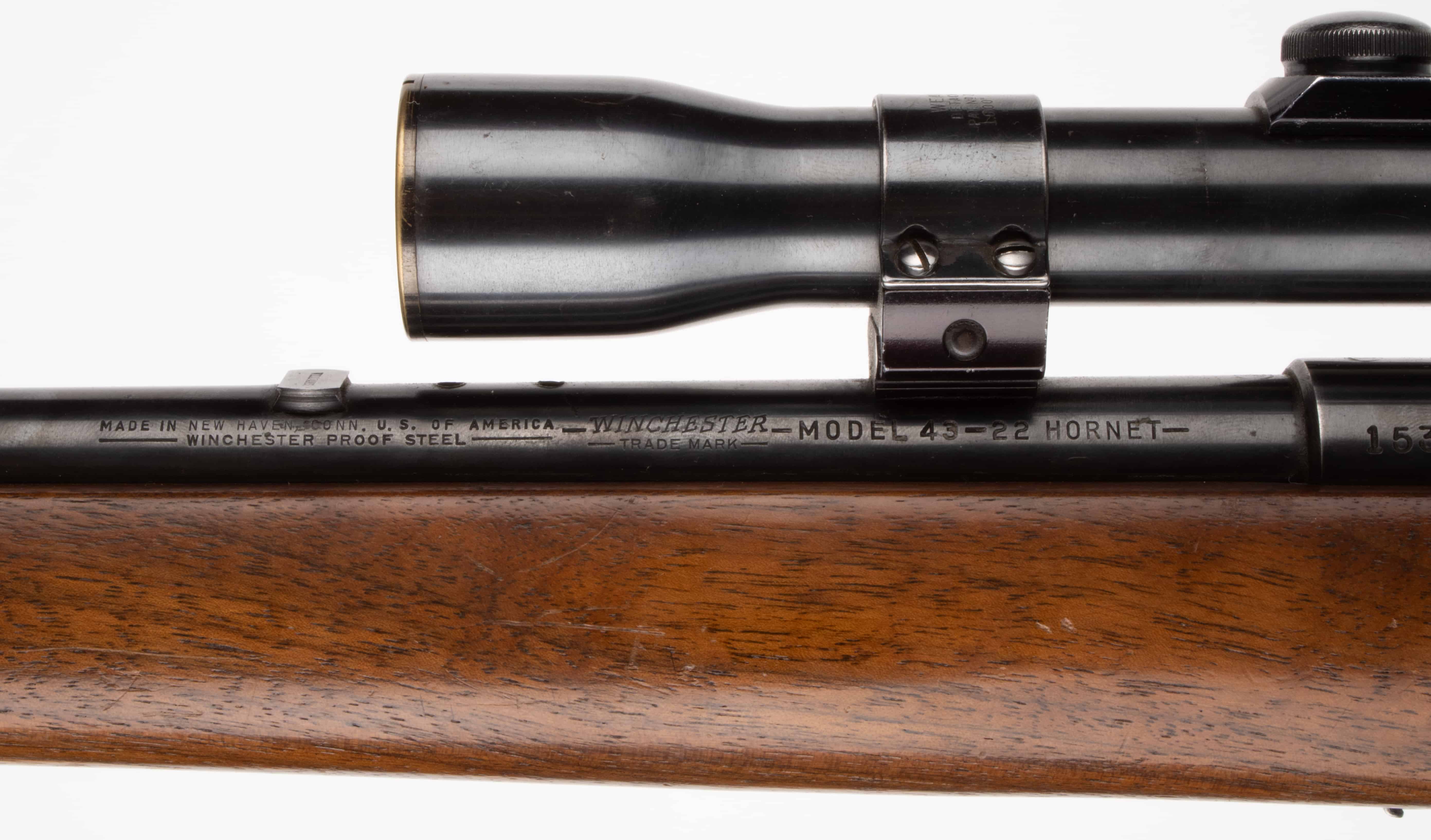
What is the Winchester Model 43?
Introduced in 1949, the Winchester Model 43 is a magazine-fed bolt-action rifle. It was chambered in four calibers and designed to be a very small action. It is a cock-on open, controlled-feed design that sports a walnut stock with a pistol grip and a 24-inch barrel weighing approximately six pounds.
George Watrous, author of The History of Winchester Firearms 1866 – 1966, notes that Winchester first authorized the development of a new bolt action repeater with a detachable box magazine on May 31, 1944. Watrous also states that this model was to be developed as a junior Model 70 designed for smaller varmint-type calibers. This text alone might be responsible for it getting compared to the Model 70. Other than being bolt-action centerfire rifles, their designs are entirely different. If anything, it resembles a larger Winchester Model 69A .22 LR action, sharing many features from the rimfire, including the rear locking lugs.
“The Model 43 was the first postwar development in Winchester centerfire rifles. It embodied the well-proved principles of the famous smooth, fast Winchester bolt action that adapted it to that highly popular sport known as pest and small game shooting.”
-George Watrous, The History of Winchester Firearms 1866 – 1966
The Model 43 action is not very strong, and excess headspace is often found in rifles that have been shot a lot using full-powered hand loads. Winchester offered two variations: the Standard and the Special Model. The only difference between the two was the stock which I will cover below.
The rifle was not initially drilled and tapped for a scope. It wasn’t until 1950 that they began drilling the receivers to accept top-mounted scope mounts. Prior to that, the receiver only had two holes on the side to allow for a receiver sight, specifically the Lyman 57A.
The Model 43 was hardly a success for Winchester, and it stopped manufacturing the 43 less than six years after starting it. Approximately 62,617 Winchester Model 43 rifles were manufactured.
The Model 43 Special Model
The stock of the Model 43 Special differed from the standard model. The stock was made of a slightly higher-grade walnut and had a better finish. It had Winchester’s signature pointed checkering pattern on both the forearm and pistol grip. The Special model also includes a plastic grip cap and, like the standard model, retains 1-inch sling swivels.
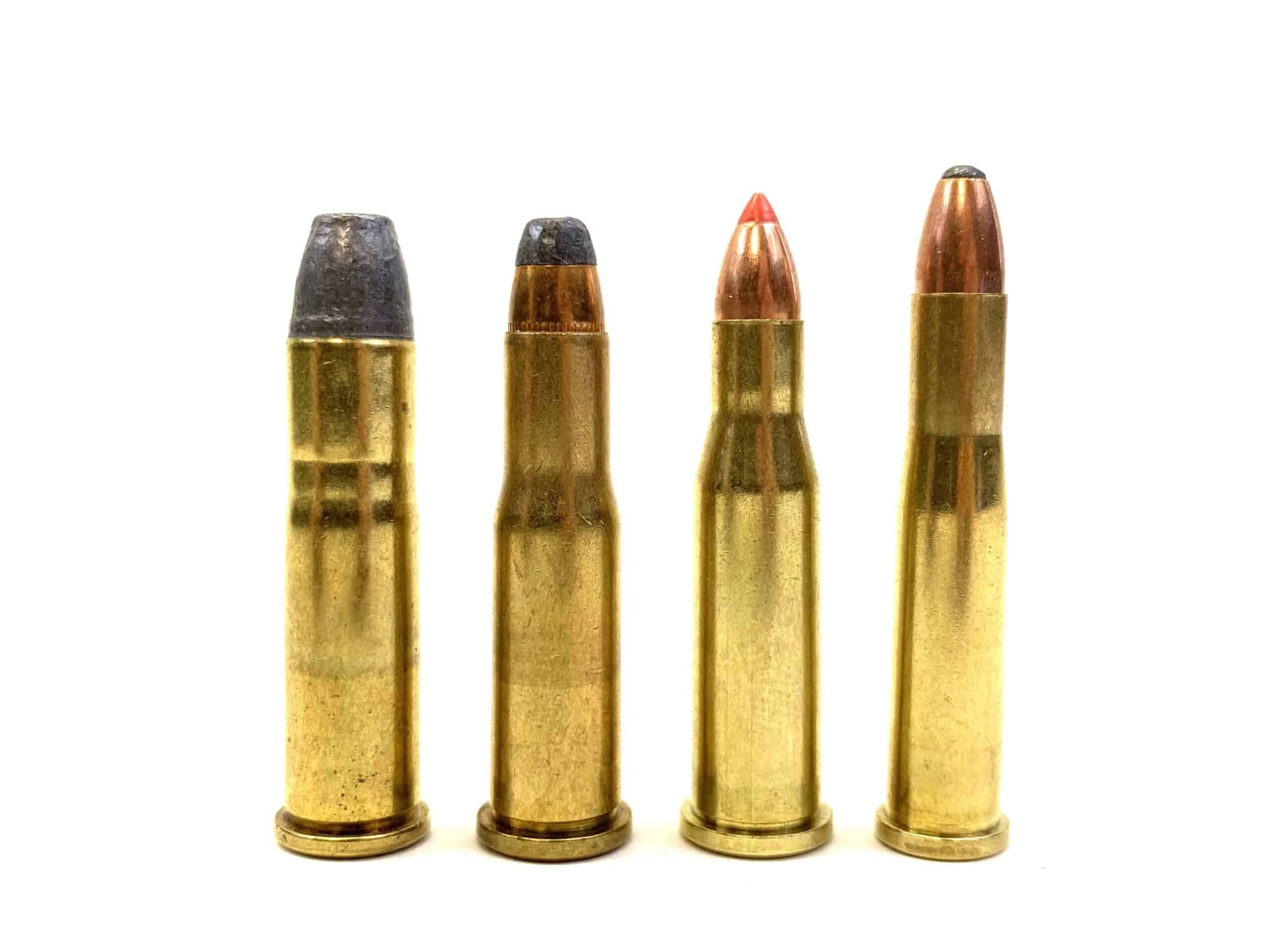
Calibers
The Winchester Model 43 was available in four calibers; the 22 Hornet, 218 Bee, 25-20 Win, and 32-20 Win. The 22 Hornet and 218 Bee are the most commonly found rifles, and their production numbers far outnumbered those of the 25-20 and 32-20. The Model 43 replaced the Model 65 lever-action rifle made by Winchester. The Model 65 was chambered in the same cartridges, excluding the 22 Hornet.
The 32-20 Win was introduced in 1882 and was extremely popular in rifles such as the Winchester 1873. It was known for being an excellent small game cartridge out to 150 yards and performs well without damaging too much meat.
The Winchester Model 43: An Extremely Detailed Look
In 1893, Winchester necked the 32-20 down to .25-caliber, and the 25-20 Win was born. It had many of the same benefits as the 32-20 but with a flatter trajectory. Later, in 1938, they necked it down even further to 22-caliber and introduced the 218 Bee. The 218 Bee was advertised as having more killing power and range than the 22 Hornet. The 32-20, 25-20, and 218 Bee all have the same rim dimensions, lending to many options regarding parts interchangeability.
Lastly, the 22 Hornet. Introduced in 1930, the 22 Hornet was an immediate success and is still widely used across the globe. It was the first small-bore, high-velocity cartridge introduced for small game and varmints in the U.S. It, much like the Bee, is considered very accurate out to 200 yards. It was the last cartridge to be added to the Model 43 line.
| 22 Hornet | 3 + 1 |
| 218 Bee | 3 + 1 |
| 25-20 Win | 3 + 1 |
| 32-20 Win | 2 + 1 |
When Was the Winchester Model 43 Made?
The Winchester Model 43 was manufactured by Winchester Repeating Arms from May 1948 to December 1953.
Below are the dates of manufacture according to the serial number. These dates are based on Winchester’s polishing room records which documented when each receiver was polished. However, polishing was one of many manufacturing steps, not the final step. Therefore, these numbers don’t necessarily represent when the rifle left the factory. These polishing room records are the most complete Model 43 records and are widely accepted as the standard.
| 1948 | 1 — 6525 |
| 1949 | 6526 — 16737 |
| 1950 | 16738 — 36915 |
| 1951 | 36916 — 52325 |
| 1952 | 52326 — 59767 |
| 1953 | 59768 — 62617 |
The serial number on Model 43 rifles is found on the front ring of the receiver, above the stock line. Initially, they were positioned on the left side but later changed to the right one once the A-Series came about.
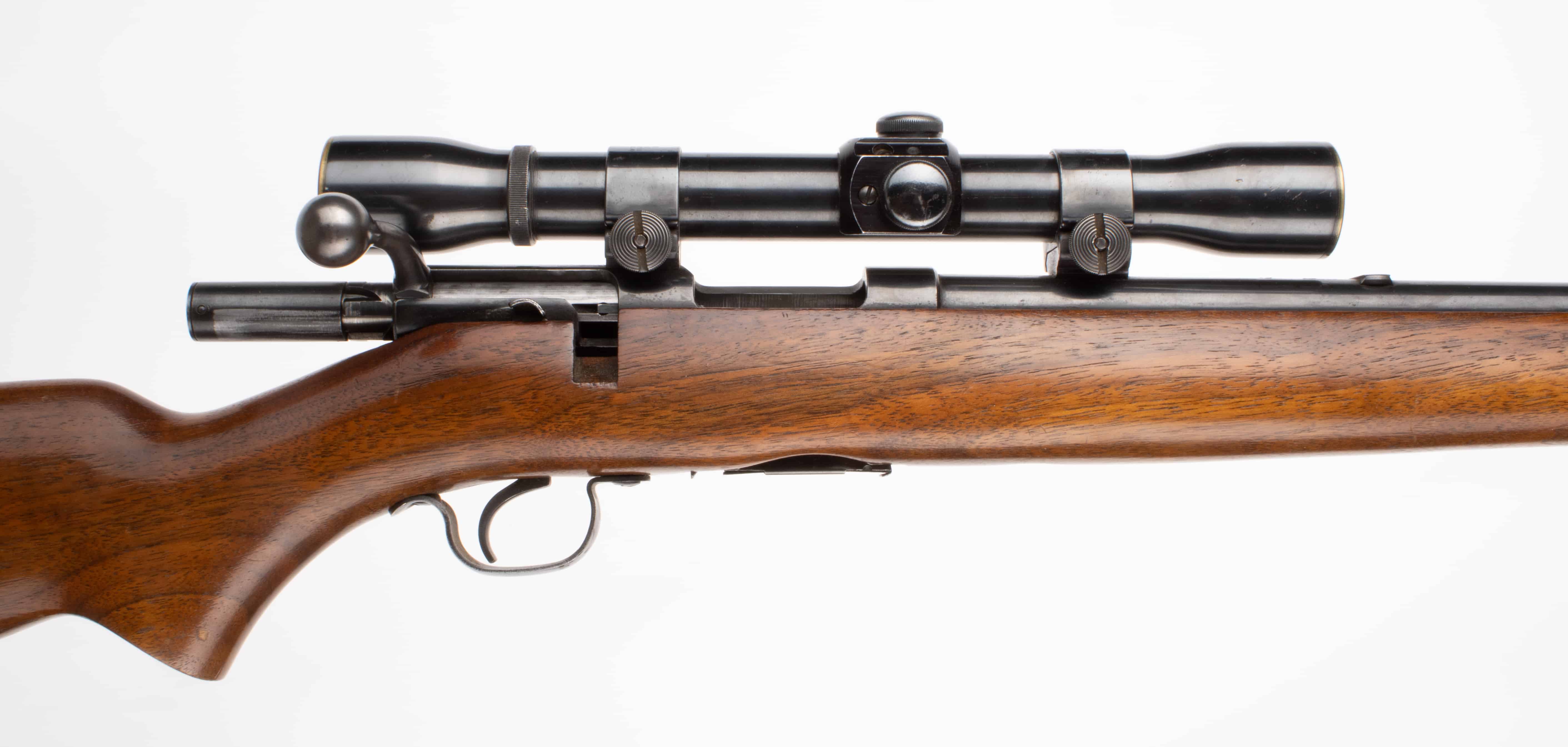
Winchester Model 43 Design Changes
Throughout the six years of production, the Winchester Model 43 underwent five design changes. In an article by Bert Hartman, these are best outlined in the Winchester Arms Collectors Association’s Spring 2016 magazine. He covers each design change in detail in this article. However, I will only summarize them here.
- The serial number locations were changed from the left side of the receiver to the right. This change was made sometime around the end of 1949.
- The bolt handle was changed from a straight design to a swept-back one. According to Hartman’s extensive research, this transition occurred between serial numbers 4,100 – 6,200.
- The 22 Hornet was added to the cartridge list for the Model 43 in November 1948, around serial number 5,500.
- A-Series rifles were quietly introduced. I will go into more detail about this below.
- Lastly, in late 1950, Winchester began to drill and tap receivers for scopes. Identified by the rear receiver bridge shape. Which will be covered below as well.
That is a list of the changes made throughout the production of the Model 43. Some are less significant than others; however, all should help you identify rifles for authenticity.
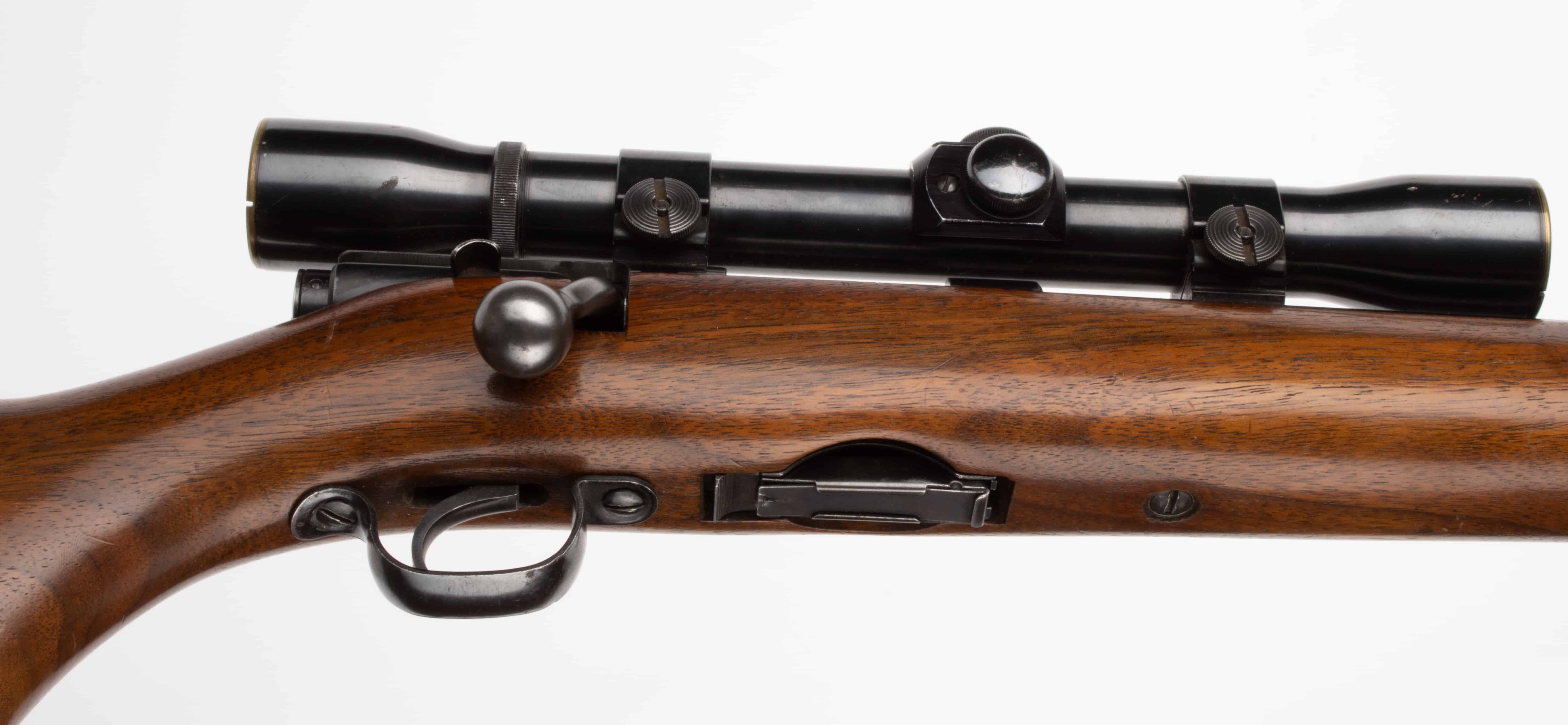
The A-Series Model 43
The “A-series” Model 43 refers to a change Winchester made to the design in 1950 and is identified by an “A” suffix added to the serial number. These changes were substantial and affect the parts interchangeability of Pre-A Series rifles.
Along with the change in the location of the serial number, the “A” suffix was added to note a pretty significant design change, the locking lug. The locking lug’s size and shape and the corresponding receiver channel were changed. The locking lug was made more narrow and taller, which we can assume was done to strengthen the lock-up of the bolt during firing.
Regarding parts interchangeability, the bolt assembly of an A-series rifle will not work in a non-A series and vice versa. The only part that was changed was the breech bolt cocking sleeve, and if needed, a bolt could be adapted to the other model by changing this part to the correct one.
It is important to note that Winchester never advertised this change.
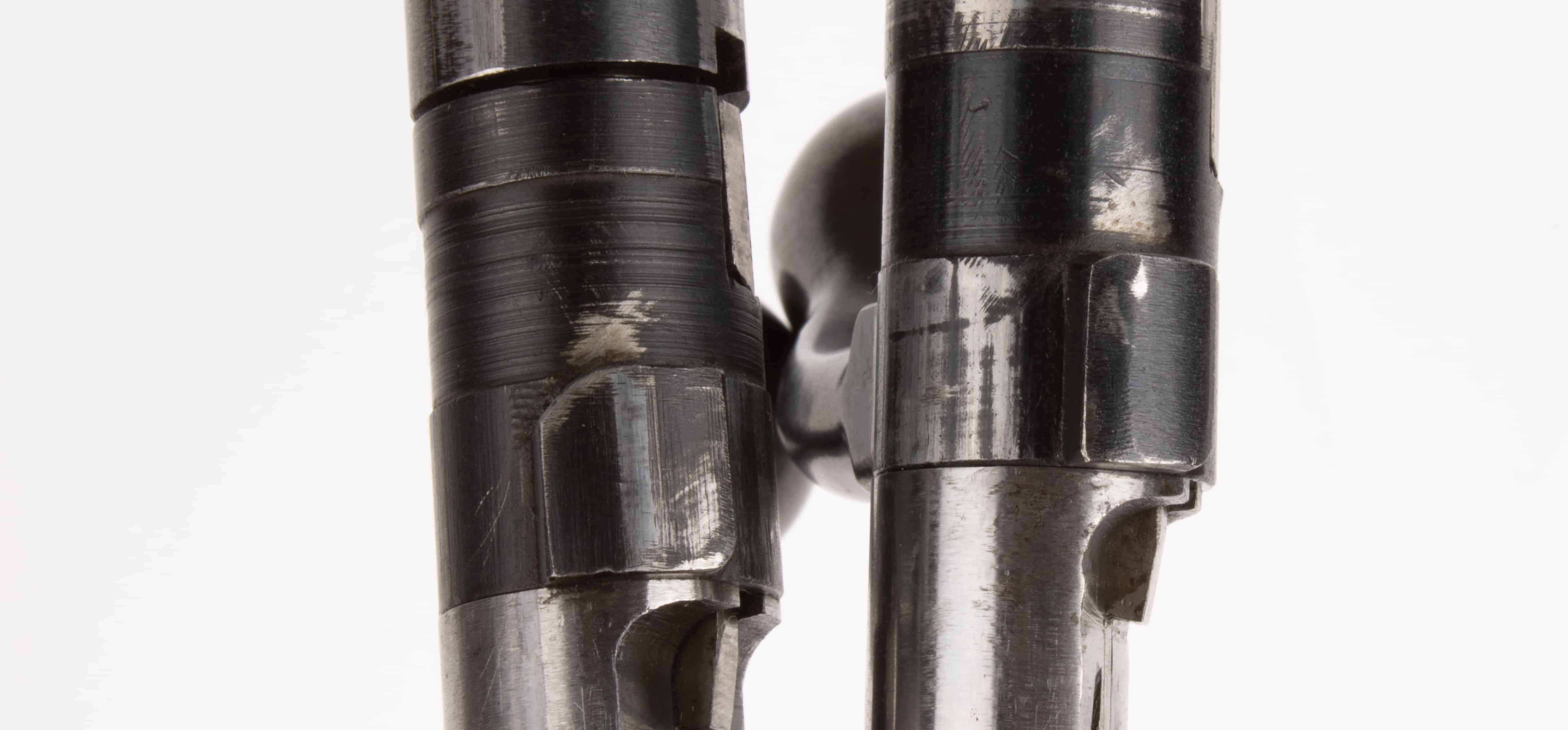
Use coupon code KTG10 to get 10% off your order of $150 or more at Brownells.
Evaluating the Value of a Winchester Model 43
Despite being labeled as a “Poor Man’s Model 70,” the Winchester Model 43 has brought everything but poor man’s prices in recent years. Many things affect the price of the Model 43 rifle. Condition obviously plays into it but has much less effect than being drilled and tapped for a scope when it shouldn’t have been. While some Model 43s were drilled and tapped, others were not. So how do you determine if it was done at the factory or by a gunsmith down the road?
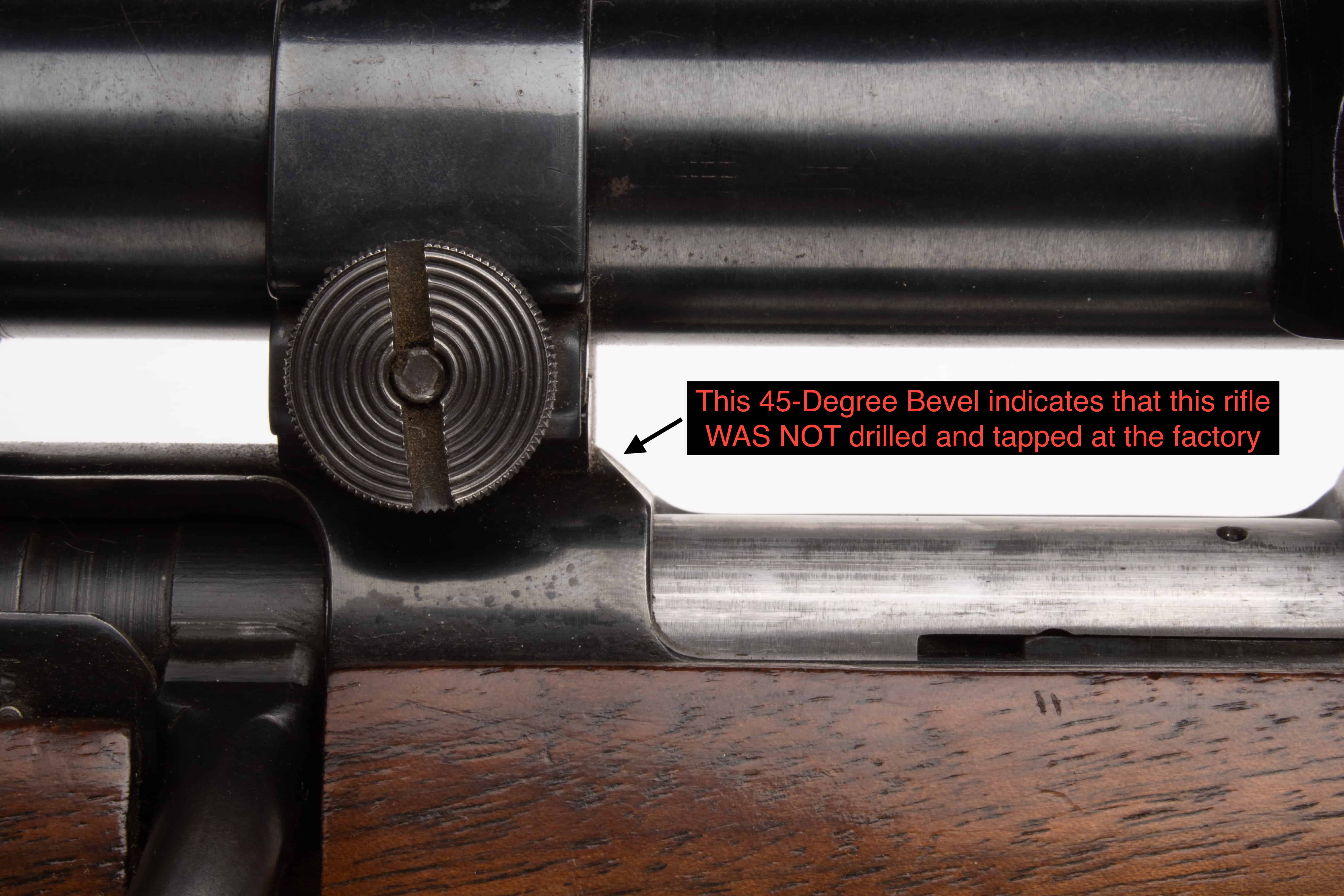
Was the Winchester Model 43 Drilled and Tapped for a Scope?
The Winchester Model 43 was drilled and tapped from the factory. However, it wasn’t until midway through production that the Model 43 was drilled and tapped for a scope. Fortunately, it is pretty easy to determine if a rifle was originally drilled and tapped. Receivers that were not drilled and tapped at the factory have a 45-degree bevel on the rear receiver bridge. The barrels of Winchester Model 43s were never drilled and tapped at the factory.
Before this change, Model 43s only had open-sight options, with the exception of the Stithe mount. The receivers on all 43s were drilled and tapped for a Lyman 57A receiver sight. The Stithe company made a scope mounting system using receiver sight holes and rear sight dovetail. This mount requires no modifications to the receiver and doesn’t hurt the collector’s rifle value.
Market Values
According to the Blue Book of Gun Values, the value of a Winchester Model 43 is affected by the following, in addition to the condition;
- Add 100% for Deluxe Model with fancy checkered wood.
- Add 150% for .32-20 WCF and .25-20 WCF cal.
- Add 20% for .218 Bee cal.
- Subtract 25% if non-factory drilled and tapped (early models).
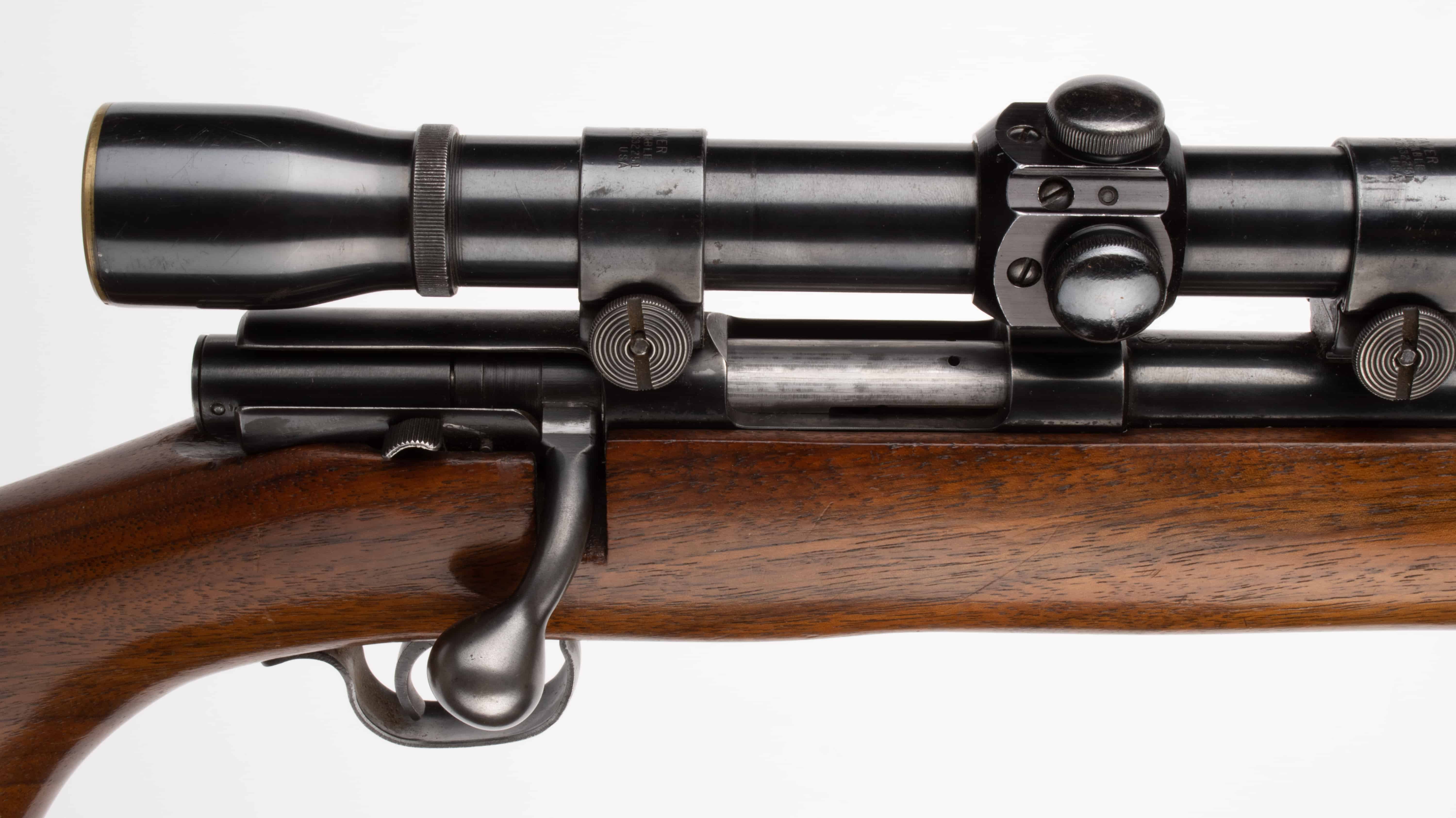
Why I Love the Winchester Model 43
The Winchester Model 43 holds a special place in my heart. It was my first rifle. My grandpa bought both my brother and me Model 43s when we were born. My brother was gifted the 22 Hornet, and me the 218 Bee. When I became obsessed with hunting as a young kid, my gun cabinet was pretty thin, and the Model 43 went into the woods with me for everything imaginable.
While it never caught on like the Model 70 or Model 94, the Winchester Model 43 is a great rifle. I don’t know if my grandpa knew how obsessed I would become with classic rifles when I was older, but he definitely has a good taste in rifles.
Digging Down Deep – Winchester Model 43 Action
The following article is for those who really want to know everything about the Model 43. It was too much information to include in the same article and is beyond what most would find useful. Collectors and gunsmiths alike will benefit from this.
The Winchester Model 43: An Extremely Detailed Look

Written by: Kurt Martonik
Kurt is a Gunsmith, Reloader, Hunter, and Outdoorsman. He grew up in Elk County, Pennsylvania, where he became obsessed with the world of firearms. Following high school, Kurt enlisted in the United States Air Force as a Boom Operator, where he eventually rose to the position of Instructor. After his military service, he attended the Colorado School of Trades(CST) in Lakewood, CO for gunsmithing. Following graduation, he accepted a job at C. Sharps Arms in Montana, where he worked as a full time stockmaker and gunsmith.
Wow! I was looking for a part the other day and said to myself: I haven’t seen this article before. Well, I guess you just posted it yesterday I’ve got a pair of 43s I have been restoring. They were very popular on fishing boats in Washington and Alaska. Used for shooting crab bait and seals.
One has 20 inches of good barrel off a 22-250 Varmint rifle 1:14 and shoots about 3/4 inch groups pre A. The other is a Bee and was an absolute basket case. A serial number had been on a fishing boat and had a lot of surface corrosion. I took the corrosion off by rolling the barrel and receiver on my bench stones for about a week in the evenings and saved all of the roll markings on both. A friend tipped me off to a pristine barrel and as it stands all that remains to be done on that one is to finish the stock. I was able to save the factory installed Lyman 57A and rebuild it. It also has a very unique dovetail filler blank that a Winchester rep from the 50s told me is a genuine factory filler blank.
The original barrel is good looking but has a bit of pitting in the bore, if it doesn’t shoot as a 218 I’ll have it re bored and chambered for 32-20.
I’ve also got a pristine, perhaps never installed, Hornet barrel with original sight hood and just bought another 43 Hornet with damage to the chamber, that way I’ll have a pair or factory 43s and the one with the 20 inch 1:14 barrel.
They are a terrific lot of fun to work on and restore. I’ve got one Hornet shooting great and am only about a month from getting the Bee going. I’m planning to use them in lieu of my CZ 527s in 22 & 17 Hornet this chuck season on days when I’m shooting 150 – 175 yards or so max.
JD, thank you! I have another couple of articles on the Model 43 that I’m working on that I will have done in the next couple of weeks, they are digging deeper yet, and by the sounds of it, they will be right up your alley!
That is very interesting to hear about their use on fishing boats, I have never heard that before! Those sound like beautiful rifles! I’m jealous of that 22 Hornet barrel you have. I have a very good condition 25-20 Win barrel that has a bulge about 6 inches down the bore. My plans are to get my hands on a Bee action someday and line the barrel of the bulged one so that I can play around with the 25-20 a bit.
The 43 barrel has such a gradual taper that it seemingly was common practice by someone to cut the breach end off of barrels that I assume were heavily pitted at the breach due to use of corrosive primers in the 1950’s and rechamber them and cut a new dovetail slot for the barrel stud. I’ve seen a few of these “carbines” locally. Other than they have roll marking that ends where the receiver begins and the caliber has been stamped to the left of the roll stamping on the barrel they look OK. They look professionally done and all looked the same to the best of my recollection. I haven’t seen one in years and that was before I became real interested in 43s.
I have a custom kid’s stock for a 43 here that looks kind of like it was styled after a Remington Mohawk. If I can come up with a receiver I have a barrel that is pitted at the breach end that I can cut off and make up a cute little varmint rifle for my kids’ with.
A few things that may be of use to others that I’ve learned the hard way:
The rear action screw pitch is something like .200-36. Anyway, you are probably not going to find anything with that pitch. I have a Bubba’d up one I was going to have welded up and restore. Since I fell into three or four NOS ones, I’m going to have it cut off and welded to a piece of 12-32 to use for an inletting and bedding screw.
The front one that goes into the barrel lug is IIRC 1/4-24 and originals are very hard to come by. But at least they could be made from a cap screw of the correct length.
Model 69 barrel lugs can be drilled and tapped on a lathe and turned into Model 43 barrel lugs. It’s way easier to find the former than the latter.
The trigger adjustment screw for a Model 69 will work on a 43. Out Back Gun Parts makes springs for the 69 that are softer and correct coil diameter. They also have original weight springs.
Lyman has a lot of parts for the 57 series and a lot of them can be used on the 57A. For $30 plus parts they will overhaul your sight, or you can order the parts and install them yourself. The length on the windage screw varies and you will need to know which one to order it. So long as you have the base, you are probably golden. I’m not sure if one of the plungers they have will work, but a plunger would not be hard to make. Mine was able to be salvaged.
Thanks JD, great information!
I wish they would show an arrow pointing to what they call the 45-degree bevel on the rear
receiver ring!
Gerald, thanks for the feedback, I just updated the image to point out the 45-degree bevel!
Hi Kurt,
I’m wondering if the dovetailed barrel stud will remain tight over time if the barrel stud is bedded in a solid bedding compound.
I’m certain that the original wood distributes the impact force over a much longer period than does an unyielding bedding compound making that an entirely satisfactory arrangement. But am thinking that if the slot becomes loose at all even with the relatively low recoil of the Hornet & Bee it will still be enough of an impact load to very slightly peen the un hardened steel of the barrel and stud just slightly, but the effect will be cumulative. So long as the dovetail is snug, I think it is probably nothing to worry about. But if it becomes loose at all then the barrel will get a “running start” and commence to peening the steel.
I set an aluminum tubing column to support the rear action screw without having to worry about the wood compressing. That also keeps my screw slots from getting out of time as time goes by and also have a pad of Devcon Steel between the receiver and stock from the trigger slot back and hopefully that wall also take up some of the impact load.
Just thinking ahead. I haven’t been messing around with 43’s long enough to find out if theory and practice have a positive correlation yet on this.
If it is an issue I would think that soft solder would probably be sufficient.
I don’t think that would be an issue down the road. The recoil of the Bee and Hornet is so minimal.
I am taking possession of a Model 43 tomorrow in 218 Bee that has an original Model 43 barrel w/o sights. The rifle was for sale and having never seen a “slick barrel” Model 43, I contacted the seller and expressed skepticism that it was original, as the posting had presented it as.
Research and reaching out to someone who has done a great deal of research on the Model 43 confirmed that 22 Hornet and 218 Bee with no factory sights or ramp was an option up until the 1951 model year. The barrel is proof marked consistent with having left New Haven on a rifle specifically set up to be used with a scope. But the receiver went through the finishing room very late in production, well after the option of having no front sight ramp had been dropped.
The asking price was in the right ball park for a common garden variety standard grade 43 in 218 Bee and since this rifle was produced at the end of the production run and Winchester would have been trying to use parts they had on hand, it is likely they would have had a barrel w/o sights available to put a rifle together with.
I looked it over today and everything seems to be as advertised. There is no evidence of the barrel having had the sight ramp turned off and refinished, It is in very nice condition overall and the bore is about as good as they come these days.
Once I get it home and have correct fitting screwdrivers handy I am curious as to what the date stamp on the barrel is. That could help in sorting it out convincingly. Either way, at a bare minimum it has an example of a Model 43 barrel that left New Haven on a rifle w/o sights on it. If it turns out that it is far more likely than not an original sightless Model 43, I’m more likely to trade it off to a collector than to turn my kids loose on rockchucks with it.
It really is a neat looking rifle w/o the front sight ramp, and it validates my earlier thoughts regarding a 43 with a clean barrel would make handsome rifle. I have actually been kicking around the idea of doing one up like that if I came across a rough one to “restore” at the right price. I had been thinking that a 43 with a Weaver or Unertl Vulture 12 power scope it would be quite the package.
Fixed typos
I am taking possession of a Model 43 tomorrow in 218 Bee that has an original Model 43 barrel w/o sights on it. The rifle was for sale and having never seen a “slick barrel” Model 43, I contacted the seller and expressed skepticism that it was original, as the posting had presented it as.
Research and reaching out to someone who has done a great deal of research on the Model 43 confirmed that they were available in 22 Hornet and 218 Bee with no factory sights or ramp as an option up until the 1951 model year.
The barrel is proof marked consistent with having left New Haven on a rifle specifically set up to be used with a scope. But the receiver went through the finishing room very late in production, well after the option of having no front sight ramp had been dropped.
The asking price was in the right ball park for a common garden variety standard grade 43 in 218 Bee and since this rifle was produced at the end of the production run and Winchester would have been trying to use up parts they had on hand, it is likely they would have had a barrel w/o sights available to put a rifle together with.
I looked it over today and everything seems to be as advertised. There is no evidence of the barrel having had the sight ramp turned off and refinished, It is in very nice condition overall and the bore is about as good as they come these days.
Once I get it home and have correct fitting screwdrivers handy I am curious as to what the date stamp on the barrel is. That could help in sorting it out convincingly. Either way, at a bare minimum it has an example of a Model 43 barrel that left New Haven on a rifle w/o sights on it. If it turns out that it is far more likely than not an original sightless Model 43, I’m more likely to trade it off to a collector than to turn my kids loose on rockchucks with it.
It really is a neat looking rifle w/o the front sight ramp, and it validates my earlier thoughts that a scoped Model 43 with a clean barrel would make handsome rifle. I have actually been kicking around the idea of doing one up like that if I came across a rough one to “restore” at the right price. I had been thinking that a Model 43 without sight ramp and a Weaver K12 or Unertl Vulture 12 power scope would be quite the package.
I call ‘em the “rich man’s model 69a”
I like that one!
Excellent article. I have a Winchester Model 43 32-20 Serial number 3694. On the barrel, it says “Winchester Model 43 32 Win”. It’s clip fed, bolt action with a straight bolt, has not been tapped for a scope. I cannot find any information on the model number on the Winchester website. It hasn’t had a round through it since the mid 60’s.
I took it to a local gunsmith and he said it was manufactured in 1949. From your article, I believe it was manufactured in 1948. It’s in very good shape (not sure if it would be classified as excellent. Rifling looks brand new. It was handed down from my grandfather and I’d like to pass it to my son. Any idea where I can get documentation as to when it was made, value, or possibly an owners manual?
Thank You
Hey Michael, thank you for the kind words. It is hard to say when it was actually manufactured as the only records known are from the polishing room, which wasn’t the final step in the process. Therefore, to my knowledge, there isn’t any real way to get an exact date on when it left the factory. That is a great rifle to have and sounds like a collectors dream!
There should be a date stamp at the breach end of bottom the barrel when you take it out of the stock that will help to narrow it down some.
1948 is what I get looking up that serial number.
In 1950 Winchester simplified their line and dropped some options. The Model 43 in 25-20and 32-20 were among the offerings that were to no longer be in the catalogue starting 1951